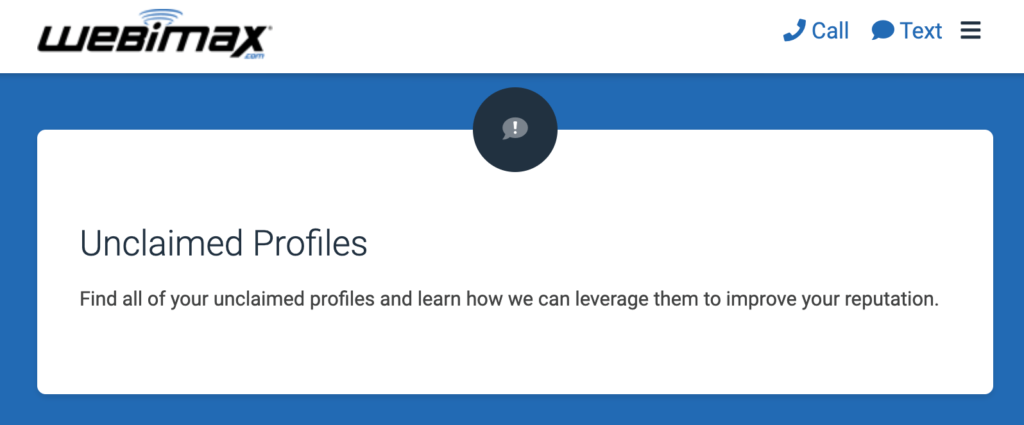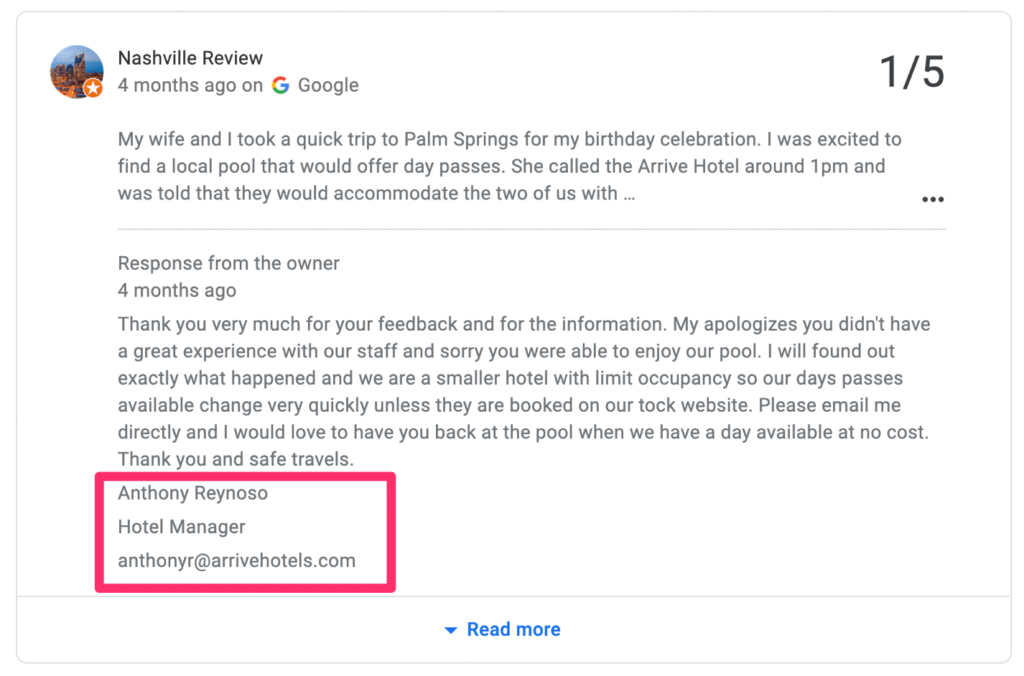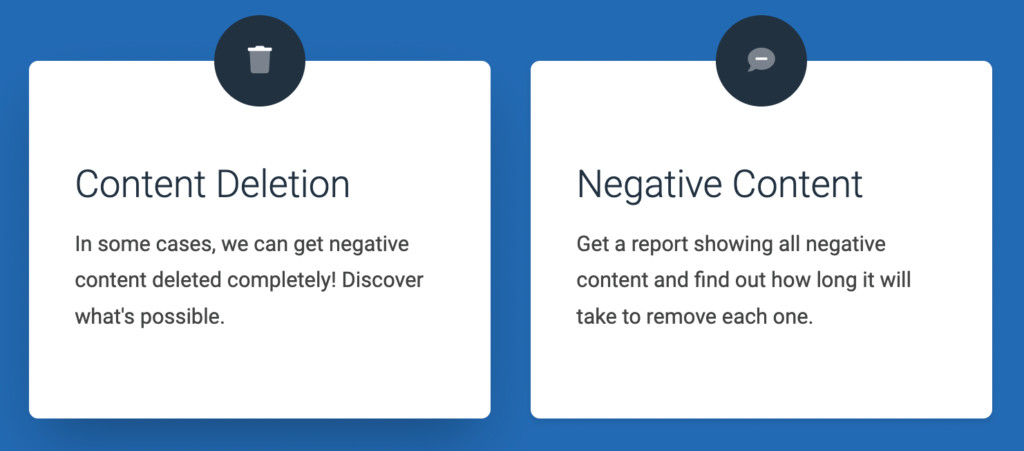Want to just get started? Click here to sign up for WebiMax and respond to negative reviews today.
Negative reviews are inevitable.
Regardless of your business type or industry, some of your customers will have a bad experience and write about it online.
Fortunately, negative reviews don’t need to define your online reputation.
With the right response, you can turn a bad review into a positive spin—salvaging your relationship with that customer and showcasing your company in a favorable light to others when they’re researching your business.
This step-by-step guide will show you the best way to handle negative reviews and respond appropriately.
The Top Online Reputation Management Companies to Respond to Negative Reviews
Managing reviews is challenging at scale. Using a reputation management company makes this process much easier, and they’ll help you with other aspects of your online reputation beyond negative reviews.
- WebiMax — Best for small businesses that need a hands-on solution
- NetReputation – Best for ultra-responsive customer support
- InternetReputation.com – Best for personal reputation management
- Reputation Defense Network — Best for permanently removing false content
- Podium — Best for getting reviews automatically
- SEO Image — Best for legal and medical practices
- Gadook — Best for rebranding after reputation attacks
- BirdEye — Best for getting Google and Facebook reviews
- Reputation.com — Best for knowing your competition’s reputation
- Go Fish Digital — Best for improving Yelp reviews
- Netmark.com — Best for hands-off, fast responses to reputation hits
You can read reviews of each online reputation management company here.
5 Steps to Respond to Negative Reviews
Whether you have a single negative review that needs some attention or you’re looking for a scalable way to manage online reviews, these five simple steps will walk you through the process:
- Claim Your Business Profiles
- Monitor Your Reviews
- Craft the Response
- Make Improvements
- Get More Positive Reviews to Drown Out the Negative Ones
The Easy Parts of Responding to Negative Reviews
Negative reviews are easy to spot. So if you’re looking for a silver lining here, you won’t have to dig too deeply to find comments with negative sentiment. And if you’re struggling to find negative reviews, it’s obviously a good thing.
Most business owners think it’s hard to explain themselves when replying to negative reviews. But in reality, you can repair things pretty quickly without having to do a thorough investigation or anything like that.
Potential customers who are checking out your reviews do not want to see excuses when you respond to negative reviews. After all, they do not want to receive an excuse when they choose your business. They just want you to guarantee that they will have a smooth experience and that you fixed the problem. They rarely care why it happened.
Finding out exactly what happened or what went wrong is much less important than empathizing with the customer and offering a resolution. Replying with things like, “we are short-staffed right now” or “we had an internet outage” won’t solve anything.
The person in charge of responding to online reviews doesn’t actually need to know the exact details of the event to rectify the situation and respond appropriately.
Try to offer to fix the problem that led to the negative review. Ask the customer to reach out directly. You may find that some customers really will contact you directly and discuss the problem. The customer may even be willing to change the negative review to a positive one if your interaction goes well.
Keeping track of all your reviews across multiple platforms can feel like a full-time job. But online reputation management services like WebiMax simplify this process by putting all your reviews on a single dashboard for easy management. You can even reply directly from that dashboard without needing to switch between multiple review sites.

WebiMax has a wide range of solutions and services that help you respond to negative reviews and improve your entire online reputation. They can handle things like unclaimed profiles and negative content deletion, and help you get more positive reviews across multiple sites.
The Difficult Parts of Responding to Negative Reviews
Lots of business owners struggle with the mental concept of negative reviews. It hurts when people say bad things about your business, especially if it’s something that you’re passionate about.
I know this is easier said than done, but try not to take things personally.
Taking it personally often leads to impulsive and irrational responses, which is the exact opposite of what will help you in this situation. The last thing you want is to get into an argument with a customer online or write something that you’re going to regret.
In fact, even though I usually recommend that you should respond to negative reviews as quickly as possible, this is not a good idea for everyone. If you are someone who tends to respond angrily or sarcastically when someone criticizes you in real life, you may have the same problem when responding to negative reviews.
For you, it may be helpful to take a few hours to cool down from the initial shock of seeing the negative review. Some people need to wait until the next day to fully gain control of their emotions before responding. Although it is nearly always better to respond quickly to negative reviews, if you simply cannot do this in a calm manner, waiting until you can respond appropriately is a good idea.
Learning to take negative reviews in stride definitely comes with practice. But the sooner you can master this mentality, the better it will be for your online reputation.
This will ultimately allow you to put a positive spin on negative comments. Eventually, you can use negative reviews as a way to build rapport with your customers and make your business better.
Patience is also crucial when you’re trying to repair a damaged reputation. If your business has more negative reviews than positive ones right now, this isn’t something you can repair overnight. But sticking with the plan and finding the right partner in online reputation management will make this process easier.
As one final piece of advice, it can be helpful to do some self-reflection after a negative review. Does the unhappy customer have a point? Is something lacking in your business that needs addressing? You may find that the negative review can prompt you to make a simple change to the way you deal with customers, resulting in happier customers and better reviews.
Step 1 – Claim Your Business Profiles
You need to make sure you’re replying directly from a verified business account on the platform where the review came from. Using your personal account or replying from a profile that hasn’t been fully set up is unprofessional and unadvisable.
This can feel like a daunting task if you don’t have your profiles set up yet. But rather than trying to claim dozens of business profiles across multiple platforms at once, stick with just one or two to get started.
Setting up your Google Business Profile is the logical first step. Yelp For Business should be another high-priority profile to claim.
Focus on the profiles where your current audience is spending the most time and leaving the most reviews. Certain types of businesses and industries will need to prioritize some platforms over others. For example, B2B software companies would be better off claiming a G2 profile over a Yelp profile.

If you’re struggling with this step, reach out to WebiMax. As part of their reputation management services, they offer assistance with finding and claiming your business profiles to enhance your online presence.
Only after these have been set up can you consider responding to reviews.
Step 2 – Monitor Your Reviews
Now you need to create a scalable and repeatable process for review monitoring. This holds true for both positive and negative reviews alike.
Manually checking your profiles once or twice per day is fine for smaller businesses just starting out. But it’s not a viable option if you’re getting dozens of reviews on ten platforms every day. That’s just not scalable.
Manage All Your Reviews in One Place
The review collection dashboard from WebiMax is one of my favorite features. You can access this directly from your client portal when you sign up for WebiMax’s services.

This is a single source of truth for all of your reviews from every review site. So you’ll see reviews from Google, Yelp, Yellow Pages, and more, all from one screen that’s easy to monitor—making it super simple to identify any negative reviews and reply right away.
Step 3 – Craft the Response
Once you’ve laid the groundwork for review management, it’s time to write your response.
The key to this step is personalization. You don’t want to just copy and paste the same generic response for each review—that’s insincere and will do more harm than good.
You also need to remember that anyone reading your online reviews can see your response. So while you should be replying directly to the initial reviewer, your conversation is still public.
Act Quickly
A timely response is crucial when it comes to negative review mitigation. 24 hours is the absolute maximum amount of time it should take you to respond. But you should really be aiming for 12 hours or less.
There are two main reasons for this.
First, put yourself into the mind of the customer writing the review—they’re obviously upset or unhappy. Replying quickly shows that you care and immediately makes the customer feel better about the situation.
Second, every minute that passes without your response increases the chances that other people will see that review online. Negative reviews look much better to prospective customers when there’s an appropriate reply from the business.
Apologize
I’m sure you’ve heard the old adage, “the customer is always right.” As a business owner, you know that the customer is actually in the wrong more often than not. But with that said, this isn’t the time to point fingers.
Always apologize, even if you don’t think you did anything wrong.
“I’m sorry” goes a long way. So swallow your pride, say you’re sorry, and ask for forgiveness. This is the safest way to start every reply.
Take Responsibility
Nobody wants to read a long explanation for why something went wrong. So save yourself the trouble and don’t even bother trying to come up with an excuse.
These excuses often make your business appear worse.
Unless you’re being accused of something that’s egregious or personally attacking, it’s typically in your best interest to own the mistake. Here are two hypothetical responses to showcase this point:
- Example A — “You’re right. Our takeout service can use some improvement. Thanks for the candid feedback!”
- Example B — “We’re really busy on Saturday nights, so takeout orders are slower.”
Example A is clearly the better response. Example B is just an excuse.
Offer a Resolution
Don’t lose this customer over one bad experience. Instead, use this as an opportunity to build rapport and turn them into one of your best advocates.
Let’s say you run a dry cleaning business and ruin a customer’s shirt. That person turns to Yelp and complains. Offer to replace the shirt, and give them a credit for future cleaning services.
This is much better than losing that customer altogether, and you’ll quickly recoup those costs over time as that customer continues using your services.
Move the Conversation Offline
Replying to a review shouldn’t trigger a long correspondence chain between you and a customer. Have a dedicated phone number or email address that people can reach out to for discussing this further.
Always ask the customer to reach out, as you don’t want them to put their name, phone number, or other sensitive information on a public review site.

The example above is from a one-star review on Google. As you can see from the highlighted portion, the manager left his direct email address in the response. This is much more appropriate than asking the reviewer for their phone number or contact information on a public channel.
Step 4 – Make Improvements
Some negative reviews are anomalies. Customers are in a bad mood, and there’s really nothing you can do to please them.
But other negative reviews can be a blessing in disguise. If you didn’t hear these complaints, you wouldn’t know about problems with your products or services.
Track Similar Complaints
You should keep track of all your negative reviews. A simple spreadsheet summarizing complaints should be sufficient.
Group together common complaints like:
- Slow service
- Rude staff
- Overcooked food
- Late delivery
- Too noisy
You get the idea. Some of these complaints may be out of your control. But most of them can be fixed.
Train Your Staff and Update Your Process
It’s important to keep your team on the same page when you’re addressing customer feedback. Let’s say you run a restaurant and keep getting bad reviews related to unfriendly wait staff.
Actions speak much louder than words. Telling a customer that you’ll rectify the situation is useless if they receive the same unfriendly service the next time they come for dinner.
Reminding your employees to smile, say hello, and say thank you can go a long way in terms of attitude perception by the customers.
Step 5 – Get More Positive Reviews to Drown Out Negative Ones
Once you respond to negative reviews, you should continue taking big-picture initiatives to improve your overall online presence.
Generally speaking, lots of positive reviews about your business can speak volumes compared to one or two bad comments. So make sure you ask your customers to leave reviews and make this process as easy as possible for them.
In some cases, you can even offer them an incentive to leave reviews—just make sure you aren’t soliciting positive reviews, as this is frowned upon.
Remove Negative Reviews
Replying to the negative review quickly and appropriately should be your top priority. But depending on the reviewer’s comments, some negative reviews might be eligible for removal.

WebiMax also offers content removal services, which is another reason why you should consider partnering with them for reputation management.
For example, certain types of reviews that could be considered promotional content, conflicts of interest, or irrelevant content are eligible for removal. But the guidelines vary from platform to platform, and these review sites don’t always actively monitor everything.
Rather than trying to navigate these waters on your own, you can let WebiMax handle it for you. They know exactly what types of reviews qualify for removal on every platform, and they have a proven formula for flagging them and requesting deletion.
from Quick Sprout https://ift.tt/pZboxjG
via IFTTT
